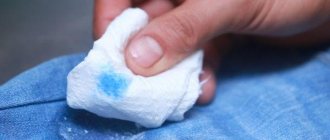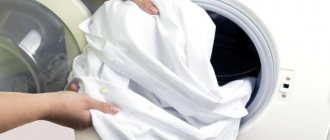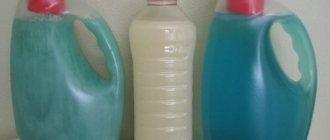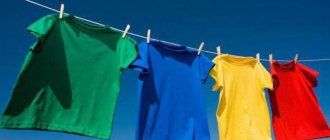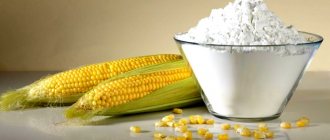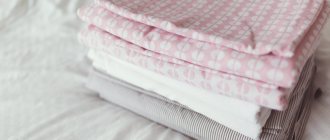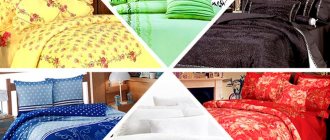Method 1 - bleaches
Factory-made bleaches, including chlorine-based products, work well with many stains, as well as yellowness on clothes. For example, white linen made from strong fabrics can easily be tidied up using ordinary “Whiteness”. This tool should be used like this:
- First, you will need to prepare a soap solution by taking three liters of water, a spoonful of powder or laundry soap, and a tablespoon of bleach. In this case, the dosage must be observed very strictly, otherwise the clothes may be damaged during washing.
- After this, the resulting solution will need to be mixed very well and things should be put into it. Products should be left in it for 20 minutes. There is no need to soak them longer in such a bleaching agent - it can damage the fabric.
- Then you should remove the items from this solution and rinse very well. Usually, after such washing, no dirt remains on the clothes.
Important: this product is absolutely not suitable for thin fabrics such as silk, chiffon, or lace. Do not put products made from such materials in water with whiteness even for a minute - they will be hopelessly damaged.
For delicate items, you can use bleaches that do not contain chlorine (for example, Vanish). They do not damage fabric fibers. Depending on the manufacturer's instructions, such bleaches must be added to the water when soaking the product or to the powder when machine washing.
Traditional methods
For those who, for some reason, do not want to use store-bought chemicals, there is a whole arsenal of folk recipes. This knowledge has been collected by generations of women who have not been spoiled by household chemicals, so there is no doubt about its effectiveness, the main thing is to find a technique that is suitable for your case.
Hydrogen peroxide
Copes with unpleasant tint on fabric and is suitable for cotton, linen and synthetics.
For a bucket of warm water you will need 3 tbsp. l. hydrogen peroxide. If such large volumes of liquid are not required, then take 1 tsp. for 2 l. The clothes should lie in this composition for about 30 minutes. Occasionally turn them over to the other side. Afterwards it should be rinsed in cold water.
If you add soda to this solution, you can restore the whiteness even to outfits that have long lost their whiteness.
Another option to enhance the effect is to make a mixture of peroxide and ammonia: 40 ml of each per 3 liters. Soak for 40 minutes. At the same time, the temperature for natural coarse fabrics can reach 70 degrees, and for wool and silk – no more than 30.
Just keep in mind that only fresh peroxide works. The disinfectant loses its properties a month after opening. This, by the way, applies not only to household needs, but also to its direct purpose – wound treatment.
Laundry soap
Modern housewives often neglect this cheap remedy. But in vain. By the way, laundry soap effectively copes with a variety of contaminants, including well brightening any fabric, even silk and wool.
For 5 liters of water, 2 tbsp is required. l. grated soap. Wardrobe items should be placed in the resulting liquid for 2-3 hours, rinsed, and then washed in the standard manner.
To enhance the effect, you can add a little (no more than 2 tablespoons) salt, soda, hydrogen peroxide, ammonia, boric acid or a couple of potassium permanganate crystals.
Soap is also used for digestion. Dissolve the grated block in 10 liters of cold water. Place things there (after covering the bottom with a white sheet) and boil for about an hour. This method is good for natural fabrics and children's blouses and pants.
Ammonia
This option is suitable for cotton and linen. You will need 3-4 tbsp per bucket of water. l. ammonia. The outfit should be placed in liquid and left for a couple of hours, then rinsed, washed and amazed at how it was before treatment and how it was after.
Soda
It is recommended for cotton, linen, synthetics and knitwear, but for a wool sweater and silk blouse it is advisable to choose a different recipe. But this safe substance is used for children's underwear. Works well both independently and in tandem with other cleaners:
- For children's things, dilute 2 tbsp. l. soda in 10 liters of water and leave to soak for 3-4 hours.
- 5 tbsp. l. soda and 2 tbsp. l. Mix ammonia with 5 liters of water, put the outfit there and wait 3 hours.
- To remove sweat stains or dirt on the collar and sleeves, prepare a soda paste: mix the powder with water to a thick paste. This mixture needs to be rubbed into the contaminated area and after half an hour simply shake off, after which all that remains is to wash the textiles. You can enhance the effect with a few drops of peroxide.
Sodium bicarbonate works well against unpleasant odors.
For washed cotton bed linen, towels, bathrobes, and socks, it is permissible to use boiling. First make a cleanser. To do this, combine a liter of water, 1 tbsp. l. soda and washing powder (the amount is calculated using the instructions on the packaging, based on the volume of liquid and the degree of contamination). If necessary, increase the volume, observing the proportions of the ingredients. Boil for no more than 30 minutes and rinse thoroughly.
Salt
Another universal method that is suitable for any grayed products. Eliminates dullness acquired as a result of frequent washing and can be used as a preventive measure.
Prepare a saline solution: for 1 liter of water, 2 tbsp. l. salt. The laundry should be soaked for about half an hour, and then the bleached items should be washed. And, of course, rinse thoroughly.
Aspirin
If you are looking for something to deal with sweat marks and rust, then use a well-known headache remedy. You just shouldn’t drink it, but use it for lightening. It is approved for wool products. Alternatively, crushed aspirin can be added directly to the washing machine. This is an excellent prevention of discoloration.
To prepare, you will need to grind aspirin into powder. The proportion is calculated as follows: one tablet per liter of water. Clothes should be soaked for at least 8 hours and then washed.
Lemon acid
A good method that works on cotton and linen items, but delicate fabrics should not be exposed to lemon juice.
To make bleach, mix water and citric acid (for every liter of liquid, 1 tablespoon of acid). Leave for 5 hours to achieve effect and then rinse.
The effectiveness will increase if you supplement the composition with a couple of spoons of powder or laundry soap.
Potassium permangantsovka
It is considered a gentle method, therefore it is recommended for all types of matter. This wonderful substance will help save light-colored outfits that have been stained because they were washed together with colored ones.
The preparation of the composition occurs in three stages.
- Dissolve 3-5 crystals of potassium permanganate in a glass of water. Just mix very thoroughly so that no particles remain.
- Lather 150 g of soap shavings in 10 liters of water.
- Combine both solutions.
Next, you need to place clean laundry in the liquid and leave for some time (from 30 minutes to several hours). The aging period depends on the type of textile: the thinner it is, the shorter the period required.
Mustard
Removes fat, disinfects and restores shine to yellowed products. Dry mustard is often used to treat kitchen towels, but it is also recommended for delicate fabrics.
Ratio of ingredients: for 1 liter of boiling water 1 tbsp. l. mustard powder. Mix and wait until the mixture sits for about 3 hours.
Next, strain it and soak the laundry. The duration, as in the previous recipe, depends on the type of canvas. For delicate materials, the time should not exceed half an hour, and towels can be left for several hours.
In difficult cases, a set of techniques is used at once, as, for example, in this video.
Method 2 - boiling
This is one of the most radical remedies that allows you to tidy up even colored linen. This method should be used like this:
- First you need to take a large container for boiling things, put laundry in it and fill it with water at the rate of 10 liters of water per kilogram of clothes. You can add shavings of laundry soap to the water - it copes very well with various contaminants.
- The container must be placed on the fire and brought to a boil. All this time, the contents of the brew must be stirred.
- After boiling, things will need to be removed from the boiling water and rinsed well several times.
Important: if you use boiling to bleach things, be sure to put all the items in the boiling water before you put it on the fire. If you put things in a pan in which the laundry is already boiling, the stains on them will go deeper into the fabric, and it will be almost impossible to wash them in the future.
To achieve better results when boiling clothes, you can add a little blue or a couple of spoons of soda to the water. This will enhance the effect of boiling and reduce the procedure time to half an hour.
Hydrogen peroxide
The editors of rsute.ru note that hydrogen peroxide perfectly whitens fabrics. You should take a deep basin, collect about 20 liters of water, the temperature of which is below 40 degrees Celsius, and then pour 330 ml of the substance. Place the laundry in the mixture for two hours. In this case, it is extremely important to stir the laundry in the basin every 20 minutes. This will help bleach the fabrics more evenly. Next, take a large saucepan, add powder, clean water and linen. Place the container on the fire and boil for about an hour. Then rinse and the products will become snow-white.
Method 3 – oil
If your favorite item has turned gray, you can bring it back in order with the help of vegetable oil. To prepare a bleaching solution based on it, you will need:
- a tablespoon of dry bleach;
- 1/2 cup washing powder;
- 2.5 tablespoons of vegetable oil (sunflower oil is suitable);
- 5 liters of warm water.
All presented components must be mixed until smooth, then put things into the resulting mixture and leave to soak for 3 hours. After this, they will need to be washed and rinsed well.
Important: with the help of sunflower oil, you can get rid of even old and difficult to remove stains. Pay special attention to this method if you need to tidy up things that cannot be boiled.
Method 4 – potassium permanganate
This product will allow you to effectively get rid of yellowness and stubborn stains on fabric. It can be used in two ways. So, if the stain is small, you should take a few crystals of potassium permanganate and add them to a glass of ordinary table vinegar, then you will need to take a cotton pad, soak it well in the resulting solution and wipe the stain with it. This product can be used even if you do not have the opportunity to organize a full wash of laundry.
If you need to eliminate a large stain or remove yellowness from an item, you will need to act differently. You should take a bucket, fill it with water, heat this water on the stove, and then add a small amount of potassium permanganate and washing powder to it. Your solution should turn out to be a soft pink color. After this, you will need to wait until this solution cools down a little, wash the items as usual and rinse them well in this product.
Method 5 – soap
This is one of the easiest ways to bleach washed laundry. It is used like this:
- Take a bar of ordinary laundry soap without fragrance. Rub it on a coarse grater or chop it with a knife.
- After this, put the soap in a basin in which the laundry is soaked, or in the powder compartment if the clothes will be washed in an automatic machine.
- After this, the items are washed according to the selected program in a machine or manually.
Important: in order to achieve the best result from such washing, you will need to add a little soda along with soap to the powder container or to the basin with the laundry. This will help refresh even gray laundry. If this step does not give the desired result, try treating stains with hydrogen peroxide.
Method 6 - peroxide
Hydrogen peroxide can be used to whiten gray or yellowed lace underwear. It is even suitable for synthetic fabrics that cannot be boiled. Use it like this:
- Take two liters of warm water. Add 5 tablespoons of peroxide to it, stir the solution thoroughly.
- Items are pre-washed by hand or in a machine. After that, they are placed in this solution and left for half an hour.
- After this, the clothes are removed from the solution and rinsed well.
Important: this method can be used not only in cases where white linen has turned gray, but also when colored linen has lost its color intensity. This is one of the few remedies that will not spoil it.
There is another way to bleach things with hydroperite. They use it like this: take two liters of boiled water at a temperature of up to 70 degrees, add a tablespoon of soda ash, as well as a teaspoon of peroxide. Place the item in the resulting mixture for a quarter of an hour, after which it is thoroughly rinsed in regular cool water.
Important: the presented recipe can be used for those things on which yellow spots appeared a long time ago. It is also suitable for various types of fabrics.
Boiling when bleaching things with soda
Many people have already forgotten how to bleach things with soda and salt using ordinary boiling water. This method is used primarily for clothing made from natural fabrics. Even taking into account the huge selection of bleaching and detergents, as well as the fact that modern washing machines have the function of heating water up to 950C, it is not necessary to completely refuse to boil white laundry. Boiling is important when it is necessary to remove old stains or when allergic reactions to some components of the powders are observed. Habitual household chemicals are replaced with baking soda or soda ash.
The method of bleaching white underwear by boiling is quite simple:
- A large metal container - a bucket, basin, pan - is filled with water and brought to a boil;
- Prepare baking soda and household items. soap (it must first be grated): one glass per five liters of boiling water; if things are very dirty, add ammonia (one tablespoon) to the resulting mixture;
- After dissolving all the ingredients, immerse the clothes in boiling water and make sure that the items are evenly soaked;
- When the water boils again, boil the laundry over low heat for 45 minutes to two hours, stirring them occasionally and dipping them into the solution.
Attention! It is permissible to boil and boil for the purpose of bleaching only clothes made from natural fabrics (linen, cotton). If the composition of the fibers is mixed, the item can quickly become unusable as a result of boiling.
At the end of the procedure, leave the bleached items to cool in the basin in which they were boiled. Then rinse them - by hand or in the washing machine.
(Visited 5,694 times, 5,694 visits today)
Share
Method 7 - ammonia
Ammonia can be used on delicate fabrics, including wool. They do it like this:
- Take 10 liters of water, put 6 tablespoons of salt, 50 grams of powder, a spoonful of peroxide and a spoonful of ammonia into it. All this is diluted to a homogeneous mass.
- Place things in the resulting mixture and leave for 10 hours.
- After this, the products are washed by hand or in a machine, choosing a delicate wash cycle.
Tip: You can even wash silk items with ammonia. It will not damage the fabric.
Method 8 - soda
Baking soda can be used to remove stains when washing by hand, and to treat items when washing in an automatic machine. If you are going to wash the items by hand, you will need to take a basin, pour 5 liters of water into it, add 5 tablespoons of soda, and then soak the items in the resulting solution for 2 hours. After this, they can be washed with powder or laundry soap.
Important: if you are dealing with old stains, be sure to add 2 tablespoons of ammonia to this solution. It will cope well even with difficult to remove stains.
How to bleach things if you are going to wash them in a machine? You will need to take 2-3 tablespoons of baking soda and pour it into the powder compartment before washing. You can use any washing mode, depending on the type of fabric.
Video: removing stains using regular soda and hydrogen peroxide:
Details
How to restore whiteness to things at home using folk methods
It happens that things need to be bleached at home, without using store-bought products. Whitening methods using improvised means are no less effective, time-tested and have a lower cost compared to household chemicals. By following the recommendations, you can get a good result without spoiling the item.
Boiling
A cheap and easy way to whiten clothes, which can be used for thick clothes made of synthetic fabrics, linen and cotton. It is recommended to boil children's clothes to disinfect them. The advantage of this method is hypoallergenic and environmentally friendly. The procedure can be carried out in stainless steel or enamel containers. Place an unnecessary white rag at the bottom of a bucket or basin, pour water, and add washing powder or laundry soap shavings. Add ammonia (per 5 liters of water - 1 tablespoon). Temperature enhances the properties of chemicals.
Place laundry in the container and set it to heat on the fire. You need to wait for the water to boil and leave it on low gas. The contents must be stirred periodically to ensure a uniform effect. The exposure time is 40-60 minutes. If you leave laundry to boil longer, you can ruin it. If the fabrics have darkened or turned yellow, then they need to be boiled with the addition of bleach in the amount of 1 tablespoon per 10 liters of water.
REFERENCE! You can use a microwave for this method. To do this, soaked laundry is placed in it for 3 minutes. This option is suitable for socks or kitchen towels.
Hydrogen peroxide
This product can whiten laundry and is suitable for synthetics. You will need to dissolve 2 tablespoons of peroxide in 10 liters of water and wash or boil the laundry in it. Using this method you can remove all stains and dirt. To enhance effectiveness, you can add 1 tablespoon of ammonia here. The items are placed in the prepared solution for 20-30 minutes, after which they are rinsed and washed as usual.
Baking soda
Baking soda is an effective and fairly mild bleaching agent that does not damage the lint. To use, soda is mixed with washing powder before washing. To make the solution, you need to mix 10 liters of heated water and 10 tablespoons of soda. You can soak things in this solution for half an hour, then wash and rinse. To enhance the whitening effect, you can double the dose of soda and add 5 tablespoons of ammonia. Old stains can be left to soak longer or washed more than once.
IMPORTANT! Baking soda not only whitens laundry, but also destroys germs.
A paste of baking soda and water is often used to remove a variety of stains on clothing, such as those caused by deodorant or wine. To do this, you need to soak a cotton pad in this slurry and lightly rub off the stains, then run the washing machine or wash the item by hand.
Salt
How to restore whiteness to yellowed white things using ordinary table salt. Make a solution in the following ratio:
— 1 liter of warm water;
- 60 grams of salt.
The laundry can be left in the prepared solution for an hour or washed by hand. After soaking, wash the laundry in the washing machine.
Mustard powder
You will need 1 tablespoon, which you need to pour 1 liter of hot water. The liquid needs to be infused for about an hour, then filtered and again left to infuse for an hour. This method will help to whiten your laundry well.
Other ways to make white linen snow-white
Everyone knows what potassium permanganate is. It turns out that she can wash white bed linen. When a few crystals are dissolved in water and it becomes light pink in color, then you need to add washing powder or grated laundry soap. The laundry is soaked in the prepared solution for 6-8 hours, then washed as usual. It is important here not to make the water too pink, otherwise the laundry may be stained.
Boric acid - for 1 liter of warm water you will need 5-6 tbsp. Leave the laundry in this solution for a couple of hours. This method can be used for machine and hand washing. If you have to wash it in a machine, then boric acid is poured into the liquid detergent compartment.
REFERENCE! For better bleaching, powder made from aspirin tablets is added to the washing machine compartment.
Stains from blood, juice, dyes, and wine can be easily removed with the help of citric acid or fresh lemon juice.
A mixture of salt, powder and vegetable oil is often recommended by housewives as a whitening agent. Copes with old stains and stubborn stains from grease, felt-tip pens, sweat, grass, blood and so on.
This product is made as follows: water is poured into a container and heated to 90 0C. A glass of washing powder, a glass of soda, and also 2 tbsp are poured into it one by one. vegetable oil and 2 tbsp. table salt. Place clothes in the prepared solution and boil for half an hour, stirring the contents occasionally. After time has passed, the gas must be turned off and the container left until it cools completely. Then the laundry should be rinsed well and dried.
Whitening clothes in a washing machine
To effectively whiten your laundry at home, washing by hand is not necessary. If you don’t have time to soak, you can try bleaching things in a machine. This method is suitable for thick fabrics and bed linen. Delicate fabrics are not recommended to be machine washed. Lingerie with lace or silk may lose color and elasticity.
To bleach in a machine, follow the following procedure:
- A detergent for a specific type of laundry is poured into the washing machine compartment. The amount of powder is calculated according to the instructions on the drug label.
- Sorted laundry is loaded into the drum of the washing machine. The washing time may vary, but the temperature must be set to at least 70 0C.
- If the machine has a stage for additional soaking of laundry, then you need to pour it into a special compartment and set the soaking time according to the type of fabric. The washing mode itself does not matter here.
- After finishing washing, the laundry should be taken out and hung.
Cotton and linen items must be washed separately from wool and synthetics, otherwise they may develop a gray tint or yellowish tint. Soiled items cannot be stored for a long time, as old stains are more difficult to remove. To prevent colored patterns and designs from fading on a white background, items must be soaked in a saline solution before washing. After the bleaching process, things should be rinsed thoroughly.
REFERENCE! Almost all washing machines have an extra rinse function.
Following these rules will help you get effective results at home. Impurities will disappear, white things will acquire a lighter shade. If the stains cannot be removed, you should contact a dry cleaner for help.
Method 9 – aspirin
Ordinary aspirin copes very well with a grayish or even yellowish tint on clothes. Use this tool like this:
- Take two liters of hot water (but not boiling water), add 5 aspirin tablets of 325 grams each. To make the tablets more easily dissolved in water, they can first be ground into powder.
- The products are left in the resulting mixture for 8 hours. If yellowness on clothes has appeared for a long time, it is better to leave things in this mixture for a day.
- After this, things are washed by hand or in a machine.
Important: when soaking things in water with aspirin, you need to make sure that they are completely immersed in water. If necessary, add a little more solution so that the water completely covers the laundry.
Aspirin can also be used for machine washing. To do this, the aspirin tablet itself must first be dissolved in water, and then the resulting water must be poured into the powder compartment. You can wash things on any acceptable mode.
Have you already read about how to bleach white clothes at home?
Whitening laundry at home using folk remedies
Experienced housewives know how to bleach laundry at home without household chemicals, using improvised means that almost everyone has. Such methods solve the problem no worse than store-bought ones, most of them are quite economical.
Boiling
The time-tested method of boiling white does an excellent job of not only removing dirt, but also safely disinfecting things.
- Prepare a clean, deep, stainless steel or enamel-lined saucepan.
- Place an unnecessary clean white cloth on the bottom of the container.
- Pour in three liters of water, add 25 grams of washing powder or soap shavings.
- For greater effectiveness, add a teaspoon of ammonia and mix.
- Entirely immerse the items that need bleaching in the liquid, put on fire, boil for about an hour and a half, stirring occasionally with a wooden spatula.
- After the specified time, remove the pan from the stove, and when the water has cooled, remove the products and rinse thoroughly.
Attention! Do not use boiling too often; this method does not have the best effect on the strength of the fabric: it wears out faster.
Soda
The product is added during hand washing or poured into the drum of a washing machine. This will eliminate the gray coating on the white product, and at the same time carry out disinfection.
We recommend reading: When ceramics require sharpening
For more advanced cases, prepare a bleaching mixture:
- 5 liters of water;
- half a glass of soda;
- 50 ml of ammonia.
The components are mixed and the clothes are soaked in the resulting liquid. Then rinse and dry.
Hydrogen peroxide
To give things crystal whiteness, soak them for half an hour by mixing:
- 5 liters of water;
- 50 ml peroxide;
- 25 ml of ammonia.
For woolen and silk items, the liquid should have a temperature no higher than 30 degrees to avoid deformation and other troubles. In other cases, in order to achieve the maximum whitening effect, the product must first be heated strongly (unless, of course, this contradicts the instructions for the product).
Ammonia
Soaking in water (5 l) with ammonia (25 ml) will help return white things to their original appearance. The clothes must be immersed entirely, otherwise unsightly yellow stains will appear on the fabric. Existing stains are wiped with an additional swab soaked in ammonia.
Important! For capricious synthetic matter, it is better not to use the product, but to choose more gentle methods.
Potassium permangantsovka
There is nothing strange in using potassium permanganate for washing, because this product has bleaching and disinfectant properties. It is added to the soap solution so that a light pink tint is obtained, and then the items are immersed for 6 hours. After this, the products are rinsed.
White
This relatively inexpensive product is familiar to many housewives; it does an excellent job of whitening even in advanced cases. However, they use Whiteness with caution, since the chlorine in its composition is aggressive towards fabrics and can irreversibly damage the item.
Advice! Use Whiteness if no other means can cope with the contamination, and make sure that the concentration does not exceed the standard specified by the manufacturer on the label.
Products can only be soaked or washed in Whiteness diluted with plenty of water. This method can be combined with boiling if the fabric is dense.
We recommend reading: Removing fresh and stubborn stains of brilliant green from the skin
Mustard powder
When bleaching lace and delicate fabrics, you need to be especially careful. But fears are unnecessary if you choose harmless mustard powder for this purpose. You will need a tablespoon of the product diluted with hot water. The liquid is filtered and the items are soaked. Then follows washing, rinsing, drying.
Boric acid
Boric acid dissolved in warm water is also a wonderful remedy for giving things their former whiteness. Clothes are soaked for 30 minutes, then washed and rinsed.
Vegetable oil
Paradoxically, vegetable oil can both leave greasy stains on fabric and help clean and whiten it. To get the right result, you need to understand what to mix with and how to use it.
Combine 5 liters of warm water, a tablespoon of any granular chemical bleach, 100 grams of washing powder and 70–80 ml of oil in a large enamel saucepan. Mix everything thoroughly and dip your clothes into the resulting solution. After 3 hours, wash and rinse thoroughly.
Aspirin
Whitening products are not only sold in stores, they can also be found in pharmacies. For example, take 5 aspirin tablets, crush them and mix with 2 liters of hot water. Soak yellowed clothing in this liquid for 8 hours or more, then wash and rinse.
Laundry soap
To remove stains from clothes, rub them with a dampened bar. And if you need to remove gray or yellowish plaque from fabric, make shavings from soap and dissolve in clean warm water. Soak the item in the resulting solution and then rinse.
Salt
To soak white items from all types of fabrics, prepare a salt solution, add a couple of tablespoons of peroxide and a dozen drops of ammonia.
Starch or baking powder
Adding baking powder or starch to the washing water helps to whiten things. In addition, they will not get dirty longer. There is no need for additional rinsing.
We recommend reading: Methods and rules for sharpening knives
Lemon acid
This food product is also an excellent whitener. To achieve maximum results, mix the acid with salt, starch and washing powder, soak clothes in the resulting solution, and then rinse.
Method 10 – boric acid
How to whiten underwear quickly and easily? Use boric acid for this purpose. To get the best result, you will need to fill a bowl with several liters of warm water and add 2-3 tablespoons of boric acid to it. Things will need to be soaked in it for half an hour and washed as usual.
Important: use this product for children's things: T-shirts, panties, socks. It will not only return the products to their former whiteness, but will also perfectly disinfect them.
Boric acid
Boric acid can be easily purchased at any pharmacy without a prescription. And it costs mere pennies. To achieve the whitening effect, you should select the “soak” program in the washing machine. Any modern model has it. The bed linen is sent directly into the drum along with two tablespoons of boric acid and the “pre-soak” program is started. Next, you need to turn on the wash at a temperature of about 60 degrees Celsius. And to enhance the effect, you can also select the “extra rinse” program. Then the boric acid will be completely washed out of the fabric.
Method 11 – mustard
Lacy underwear and light-colored items made from delicate fabrics can be bleached using ordinary mustard powder. Use it like this:
- Take a tablespoon of powder, pour a liter of hot boiled water and leave to settle for two hours.
- After this, the water is drained and new mustard is added. This step is repeated until the required amount of water is obtained for the upcoming wash.
- Then simply use the infused water to wash things with soap or powder.
Important: unlike other presented methods of bleaching things with folk remedies, this one can be used quite regularly, since it is least harmful to the fabric itself. You just need to get used to using settled water, and there will be no problems with it.
Method 12 – microwave
Microwave bleaching is most suitable for items made from dense fabrics, such as kitchen towels. It is used like this:
- To begin with, the product is well moistened under running water.
- Then the item is thoroughly soaped with laundry soap. You can also use regular washing powder instead.
- After this, the product is placed in a plastic bag, put in the microwave and left there for one and a half minutes. If the product is very dirty, you can run the microwave for 1 minute 3 times in a row at short intervals.
- After such washing, the product will need to be rinsed additionally to remove traces of soap. This can be done manually or in a washing machine.
Important: you should not do this with things that have difficult to remove stains, for example, blood stains. They can eat into the fabric. If your white linen has simply faded, this option is ideal.
Method 13 – machine wash
If you don't have the opportunity to soak your laundry for a long time before washing, you can try bleaching it in an automatic washing machine. This method can be safely used for items made of dense fabrics, for example, linen or cotton, but it will not work for delicate items, including lace underwear. You will need to act like this:
- First, you need to pour the powder itself, as well as special bleach, into the washing powder compartment. Select the dosage of these products according to the manufacturer's instructions.
- After this, you will need to load white items into the clothes compartment and run a wash cycle with a temperature of at least 70 degrees.
- Then all you have to do is wait until the wash is finished and hang your laundry out to dry. If you do everything correctly, your white clothes will be in perfect condition after this treatment.
If you have tried all available methods on how to bleach washed laundry at home, but have not achieved the desired result, take the items to the dry cleaner. There they can be put in order in just a few days.
Video: a proven method for whitening laundry and removing stains:
Traditional methods of whitening clothes
There are many different ways on how and how to bleach white linen at home.
Boiling
The oldest and most proven method, which some people successfully use to this day. To do this you will need an old bucket or large saucepan:
You need to add laundry soap to the water, which copes well with all types of contaminants.
- Things must be placed in water before the container is on the stove.
- When the water boils, the fire must be reduced.
- While boiling, things need to be stirred periodically.
- After the procedure, the laundry should be rinsed thoroughly.
- For severe contamination, you can add bleach. To do this, dilute a spoonful of this product in a liter of water, then pour the solution into a boiling container, and then put the laundry there.
Laundry soap
Not everyone likes to boil laundry; many consider this method outdated, tedious and prefer to use other methods. How to bleach white laundry at home without boiling? The simplest, most affordable and effective remedy is laundry soap, which, as a rule, can be found at any housewife. You can use it alone by dissolving it in water and soaking things in this solution, or in combination with other components.
Laundry soap plus soda
Grate the laundry soap and add the same amount of soda. You can add lemon zest for flavor. Dissolve the resulting composition in water and soak things in it.
Laundry soap plus potassium permanganate
How to bleach white underwear? For this case, we suggest you use a simple and safe recipe:
- Rub 50 grams of laundry soap and add a few grains of potassium permanganate.
- Pour this mixture with several liters of warm water, thoroughly dissolve the composition in the water.
- Place your laundry in the solution for an hour.
- Then wash it as usual.
Soda
How to bleach bed linen at home in a washing machine? Baking soda will help you, however, it will only cope with fresh stains. Just add it to the compartment of your washing machine when washing, and your clothes will shine white.
Soda plus ammonia
How to prepare a bleaching mixture based on soda and ammonia?
- Take half a glass of soda, add two tablespoons of ammonia. Fill everything with 5 liters of water.
- Mix the solution thoroughly.
- Pour into a basin and place the laundry there for several hours.
- Rinse and then machine wash normally.
Soda plus vinegar
There is a very simple way to bleach things using baking soda and vinegar - they will remove all stains:
- Moisten the problem area with water.
- Pour in baking soda.
- Pour in vinegar.
- Machine wash the product.
Ammonia plus hydrogen peroxide
Hydrogen peroxide perfectly removes yellow stains and also disinfects laundry; you can use it yourself by diluting it in water and pouring it onto the problem area. But in combination with ammonia it gives the best effect:
- Take ammonia and hydrogen peroxide in a combination of 1 to 2 and dissolve this solution in several liters of water.
- Place your items in the solution and leave for several hours.
- Stir occasionally.
- Rinse the laundry and then wash as usual.
Mustard
When whitening bed linen at home, mustard is used. Some people find this method quite effective:
- Dilute mustard powder in water and put the laundry in it.
- After some time, take out the laundry, rinse and wash as usual.
Eggshell
Few people know about this method, although it is also considered quite effective:
- Take 100 grams of eggshells, sew them into fabric and put them in the drum with dirty laundry when washing.
- After washing, you will notice that your clothes have become much whiter.
Vegetable oil
Oddly enough, the problem of whitening bed linen at home can be solved with the help of vegetable oil:
- Pour water into the container and put it on the fire, bring it to a temperature of approximately 90 degrees, but do not boil.
- Add 2 tablespoons of oil, salt, bleach, one tablespoon of soda ash, 1 cup of washing powder to the water. Mix the composition thoroughly.
- Place the items in a large container, fill with the solution, and boil for half an hour.
- After the laundry has cooled, rinse it in cold water.

